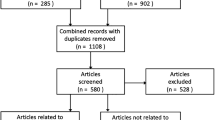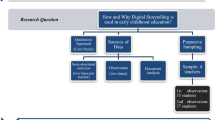Abstract
Direct exposure to violence affects approximately three out of every five children in America. Using data available from the “Do the Write Thing” (DtWT) Challenge, this study explored children’s views of violence using 1,165 essays written by students from 13 middle schools in nine districts within Region V of Texas. Data analysis from students’ writing found that students wrote more about bullying than other forms of violence. Most children identified themselves as indirect observers or witnesses rather than victims or perpetrators during such instances of bullying. Pairing the anti-bullying campaigns with violence prevention programs could better inform and educate students about the risks and consequences of violence, particularly as they move into late adolescence and adulthood.
Similar content being viewed by others
References
Baumeister, R. F., & Newman, L. S. (1994). How stories make sense of personal experiences: Motives that shape autobiographical narratives. Personality and Social Psychology Bulletin, 20(6), 676–690.
Besa, D. (1994). Evaluating narrative family therapy using single-system research designs. Research on Social Work Practice, 4(3), 309–325.
Bohanek, J. G., & Fivush, R. (2010). Personal narratives, well-being, and gender in adolescence. Cognitive Development, 25(4), 368–379. doi:10.1016/j.cogdev.2010.08.003.
Brewin, C. R., & Lennard, H. (1999). Effects of mode of writing on emotional narratives. Journal of Traumatic Stress, 12(2), 355–361. doi:10.1023/A:1024736828322.
Buckley, H., Holt, S., Whelan, S., Buckley, H., Holt, S., & Whelan, S. (2007). Listen to me! Children's experiences of domestic violence. Child Abuse Review, 16(5), 296–310. doi:10.1002/car.995.
Children's Safety Network (2011). Preventing bullying: The role of public health and safety professionals. Retrieved from http://www.childrenssafetynetwork.org/sites/childrenssafetynetwork.org/files/PreventingBullyingRolePublicHealthSafetyProfessionals.pdf.
Combs, G., & Freedman, J. (2012). Narrative, poststructuralism, and social justice. The Counseling Psychologist, 40(7), 1033–1060. doi:10.1177/0011000012460662.
Cook, A., Liautaud, J., Mallah, K., Olafson, E., van der Kolk, B., Spinazzola, J., et al. (2005). Complex trauma in children and adolescents. Psychiatric Annals, 35(5), 390–398.
Etchison, M., & Kleist, D. M. (2000). Review of narrative therapy: Research and utility. The Family Journal, 8(1), 61–66.
Finkelhor, D., Ormrod, R. K., & Turner, H. A. (2007). Poly-victimization: A neglected component in child victimization. Child Abuse & Neglect, 31(1), 7–26. doi:10.1016/j.chiabu.2006.06.008.
Finkelhor, D., Turner, H. A., & Hamby, S. (2012). Let's prevent peer victimization, not just bullying. Child Abuse & Neglect, 36(4), 271–274. doi:10.1016/j.chiabu.2011.12.001.
Finkelhor, D., Turner, H., Ormrod, R., Hamby, S., & Kracke, K. (2009). Children's exposure to violence: A comprehensive national survey. Washington, DC: U.S. Department of Justice.
Fisher, D. (2006). Responding to students who disclose the violence in their lives. English Journal, 95(6), 65–70.
Geil, D. M. M. (1998). Collaborative reasoning: Evidence for collective rationality. Thinking & Reasoning, 4(3), 231–248.
Goldbaum, S., Craig, W. M., Pepler, D., & Connolly, J. (2003). Developmental trajectories of victimization: Identifying risk and protective factors. Journal of Applied School Psychology, 19(2), 139–156.
Gortner, E., Rude, S. S., & Pennebaker, J. W. (2006). Benefits of expressive writing in lowering rumination and depressive symptoms. Behavior Therapy, 37(3), 292–303. doi:10.1016/j.beth.2006.01.004.
Green, S. B., & Salkind, N. J. (2011). Using SPSS for windows and Macintosh: Analyzing and understanding data (6th ed.). Boston: Prentice Hall.
Harris, W. W., Lieberman, A. F., & Marans, S. (2007). In the best interests of society. Journal of Child Psychology and Psychiatry, 48(3–4), 392–411. doi:10.1111/j.1469-7610.2007.01732.x.
Hepworth, D., Rooney, R., Dewberry Rooney, G., Strom-Gottfried, K., & Larsen, J. A. (2013). Direct social work practice: Theory and skills. Belmont: Cengage Learning.
Holden, G. W. (2003). Children exposed to domestic violence and child abuse: Terminology and taxonomy. Clinical Child and Family Psychology Review, 6(3), 151–160. doi:10.1023/A:1024906315255.
Howard, M. O., Allen-Meares, P., & Ruffolo, M. C. (2007). Teaching evidence-based practice: Strategic and pedagogical recommendations for schools of social work. Research on Social Work Practice, 17(5), 561–568.
Hudd, S. S., Bronson, E. F., & Bronson, E. F. (2007). Moving forward looking backward: An exercise in recursive thinking and writing. Teaching Sociology, 35(3), 264–273. doi:10.1177/0092055X0703500305.
James, V. H., & Owens, L. D. (2005). ‘They turned around like I wasn’t there’: An analysis of teenage girls’ letters about their peer conflicts. School Psychology International, 26(1), 71–88.
Kagitcibasi, C. (2013). Family, self, and human development across cultures: Theory and applications. London: Routledge.
Kaufman, J. S., Ortega, S., Schewe, P. A., & Kracke, K. (2011). Characteristics of young children exposed to violence: The safe start demonstration project. Journal of Interpersonal Violence, 26(10), 2042–2072. doi:10.1177/0886260510372942.
Kilpatrick, D. G., Acierno, R., Saunders, B., Resnick, H. S., Best, C. L., & Schnurr, P. P. (2000). Risk factors for adolescent substance abuse and dependence: Data from a national sample. Journal of Consulting and Clinical Psychology, 68(1), 19–30. doi:10.1037/0022-006X.68.1.19.
Krug, E. G., Mercy, J. A., Dahlberg, L. L., & Zwi, A. B. (2002). The world report on violence and health. Lancet, 360(9339), 1083–1088. doi:10.1016/S0140-6736(02)11133-0.
Listenbee, R., Torre, J., Boyle, G., Cooper, S., Deer, S., Durfee, D., … Taguba, A. (2012). Report of the attorney general's national task force on children exposed to violence. Attorney General's National Task Force on Children Exposed to Violence.
Luthar, S. S., Cicchetti, D., Becker, B., Luthar, S. S., Cicchetti, D., & Becker, B. (2000). The construct of resilience: A critical evaluation and guidelines for future work. Child Development, 71(3), 543–562. doi:10.1111/1467-8624.00164.
Masten, A. S. (2014). Global perspectives on resilience in children and youth. Child Development, 85(1), 6–20.
Masten, A. S., & Obradović, J. (2006). Competence and resilience in development. Annals of the New York Academy of Sciences, 1094(1), 13–27. doi:10.1196/annals.1376.003.
Maxfield, M., & Babbie, E. (2014). Research methods for criminal justice and criminology. Toronto: Nelson Education.
McDonald, R., Jouriles, E. N., Ramisetty-Mikler, S., Caetano, R., & Green, C. E. (2006). Estimating the number of American children living in partner-violent families. Journal of Family Psychology, 20(1), 137–142. doi:10.1037/0893-3200.20.1.137.
McIntyre, J. K., & Widom, C. S. (2011). Childhood victimization and crime victimization. Journal of Interpersonal Violence, 26(4), 640–663. doi:10.1177/0886260510365868.
Moylan, C. A., Herrenkohl, T. I., Sousa, C., Tajima, E. A., Herrenkohl, R. C., & Russo, M. J. (2010). The effects of child abuse and exposure to domestic violence on adolescent internalizing and externalizing behavior problems. Journal of Family Violence, 25(1), 53–63.
National Association of School Psychologists. (2012). Bullying prevention and intervention in schools. Bethesda: Author.
National Campaign to Stop Violence. (2013). Discussion paper on the causes, effects, and solutions to youth violence. Washington, DC: National Campaign to Stop Violence.
Neuman, W. L. (1994). Social research methods: Qualitative and quantitative approaches. Boston: Allyn & Bacon.
O'Connor, T. S. J., Meakes, E., Pickering, M. R., & Schuman, M. (1997). On the right track: Client experience of narrative therapy. Contemporary Family Therapy, 19(4), 479–495.
Osofsky, J. D. (1999). The impact of violence on children. The Future of Children / Center for the Future of Children, the David and Lucile Packard Foundation, 9(3), 33–49.
Pennebaker, J. W. (1997). Writing about emotional experiences as a therapeutic process. Psychological Science, 8(3), 162–166. doi:10.1111/j.1467-9280.1997.tb00403.x.
Pennebaker, J. W. (2012). Opening up: The healing power of expressing emotions. New York: Guilford Press.
Pergolizzi, F., Pergolizzi, J., Gan, Z., Macario, S., Pergolizzi, J. V., Ewin, T., & Gan, T. J. (2011). Bullying in middle school: Results from a 2008 survey. International Journal of Adolescent Medicine and Health, 23(1), 11–18.
Quinn, G. P., Bell-Ellison, B. A., Loomis, W., & Tucci, M. (2007). Adolescent perceptions of violence: Formative research findings from a social marketing campaign to reduce violence among middle school youth. Public Health, 121(5), 357–366. doi:10.1016/j.puhe.2006.11.012.
Resnick, M. D., Ireland, M., & Borowsky, I. (2004). Youth violence perpetration: What protects? What predicts? Findings from the national longitudinal study of adolescent health. Journal of Adolescent Health, 35(5), 424e1–424e10. doi:10.1016/j.jadohealth.2004.01.011.
Rose, A. J., & Rudolph, K. D. (2006). A review of sex differences in peer relationship processes: Potential trade-offs for the emotional and behavioral development of girls and boys. Psychological Bulletin, 132(1), 98–131.
Saunders, B. E. (2003). Understanding children exposed to violence: Toward an integration of overlapping fields. Journal of Interpersonal Violence, 18(4), 356–376. doi:10.1177/0886260502250840.
Shavers, C. A. (2013). Exposures to violence and trauma among children and adolescents. Health, 5(2), 298–305.
Slivinske, J., & Slivinske, L. (2014). Therapeutic storytelling for adolescents and young adults. In L. Slivinske (Ed.), Therapeutic storytelling for adolescents and young adults. Oxford: Oxford University Press.
Smyth, J. M., Hockemeyer, J. R., & Tulloch, H. (2008). Expressive writing and post-traumatic stress disorder: Effects on trauma symptoms, mood states, and cortisol reactivity. British Journal of Health Psychology, 13(Pt 1), 85–93.
Sternberg, K. J., Baradaran, L. P., Abbott, C. B., Lamb, M. E., & Guterman, E. (2006). Type of violence, age, and gender differences in the effects of family violence on children’s behavior problems: A mega-analysis. Developmental Review, 26(1), 89–112.
Vaillancourt, T., McDougall, P., Hymel, S., Krygsman, A., Miller, J., Stiver, K., & Davis, C. (2008). Bullying: Are researchers and children/youth talking about the same thing? International Journal of Behavioral Development, 32(6), 486–495.
Vromans, L. P., & Schweitzer, R. D. (2011). Narrative therapy for adults with major depressive disorder: Improved symptom and interpersonal outcomes. Psychotherapy Research, 21(1), 4–15.
Wang, M., & Holcombe, R. (2010). Adolescents’ perceptions of school environment, engagement, and academic achievement in middle school. American Educational Research Journal, 47(3), 633–662.
Wang, J., Iannotti, R. J., & Nansel, T. R. (2009). School bullying among adolescents in the united states: Physical, verbal, relational, and cyber. Journal of Adolescent Health, 45(4), 368–375.
Widom, C. S. (2000). Childhood victimization: Early adversity, later psychopathology. National Institute of Justice Journal, 242, 3–9.
Zimmerman, A., Morrel-Samuels, S., Wong, N., Tarver, D., Rabiah, D., & White, S. (2004). Guns, gangs, and gossip an analysis of student essays on youth violence. The Journal of Early Adolescence, 24(4), 385–411. doi:10.1177/0272431604268551.
Zolkoski, S. M., & Bullock, L. M. (2012). Resilience in children and youth: A review. Children and Youth Services Review, 34(12), 2295–2303.
Acknowledgements
The authors wish to acknowledge the journal reviewers for their valuable suggestions, and the teachers and children participants, the judges of the Do the Write Thing competition in Region V, Texas for their participation in this project.
Author information
Authors and Affiliations
Corresponding author
Ethics declarations
Disclosure of Interest
Authors Ginger Gummelt and Monit Cheung declare that they have no conflicts of interest to report.
Ethical Standards and Informed Consent
This study used secondary data from a writing contest. All identifiers were removed prior to the study. Informed Consent was not required. We received IRB approval from both University of Houston (Protocol Number: 14,355–01) and Lamar University (Number: 73,414,139).
Rights and permissions
About this article
Cite this article
Gummelt, G., Cheung, M. Analyzing Children’s Perception of Violence Through Their Writing. Journ Child Adol Trauma 12, 1–10 (2019). https://doi.org/10.1007/s40653-017-0151-2
Published:
Issue Date:
DOI: https://doi.org/10.1007/s40653-017-0151-2




